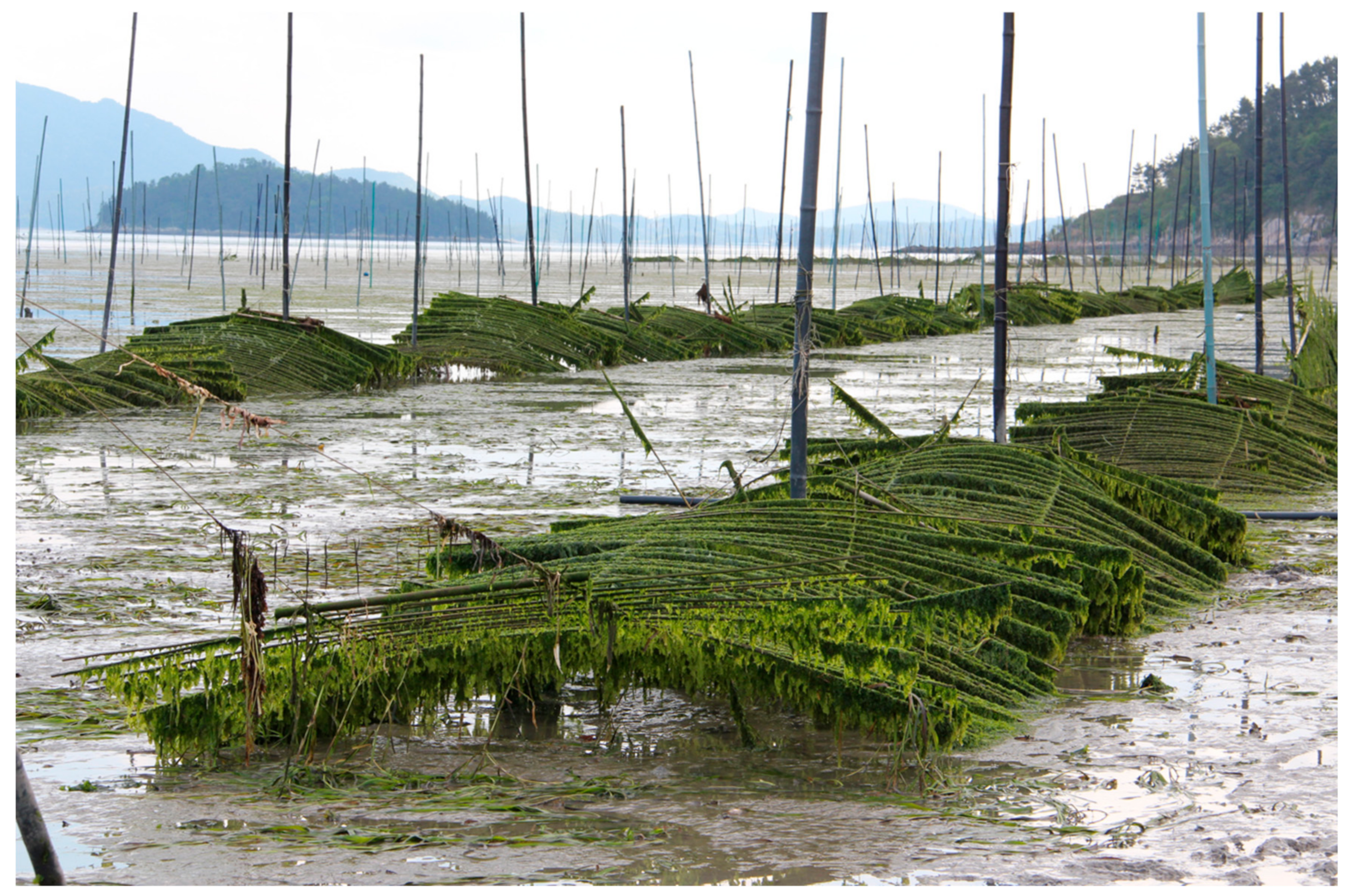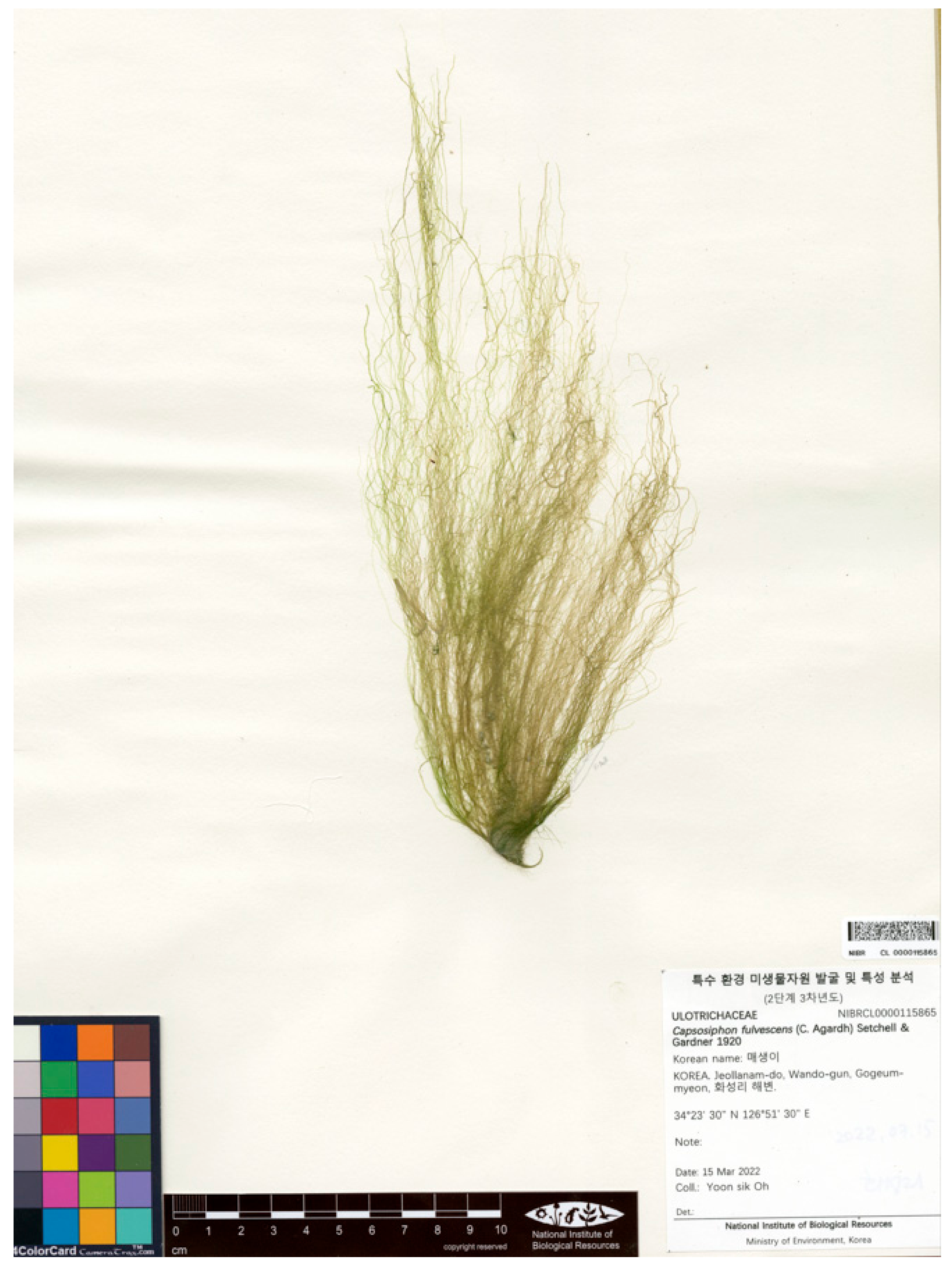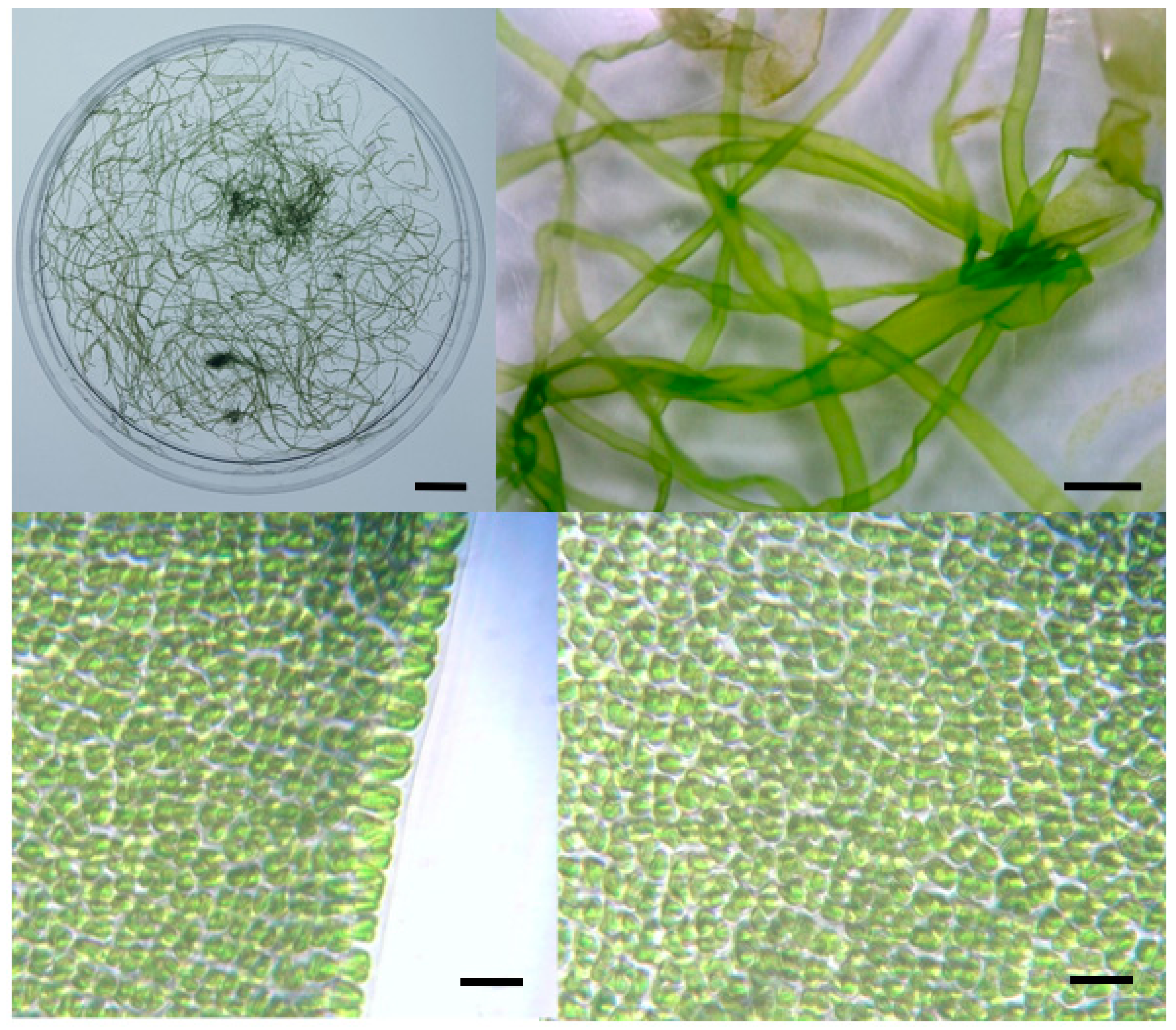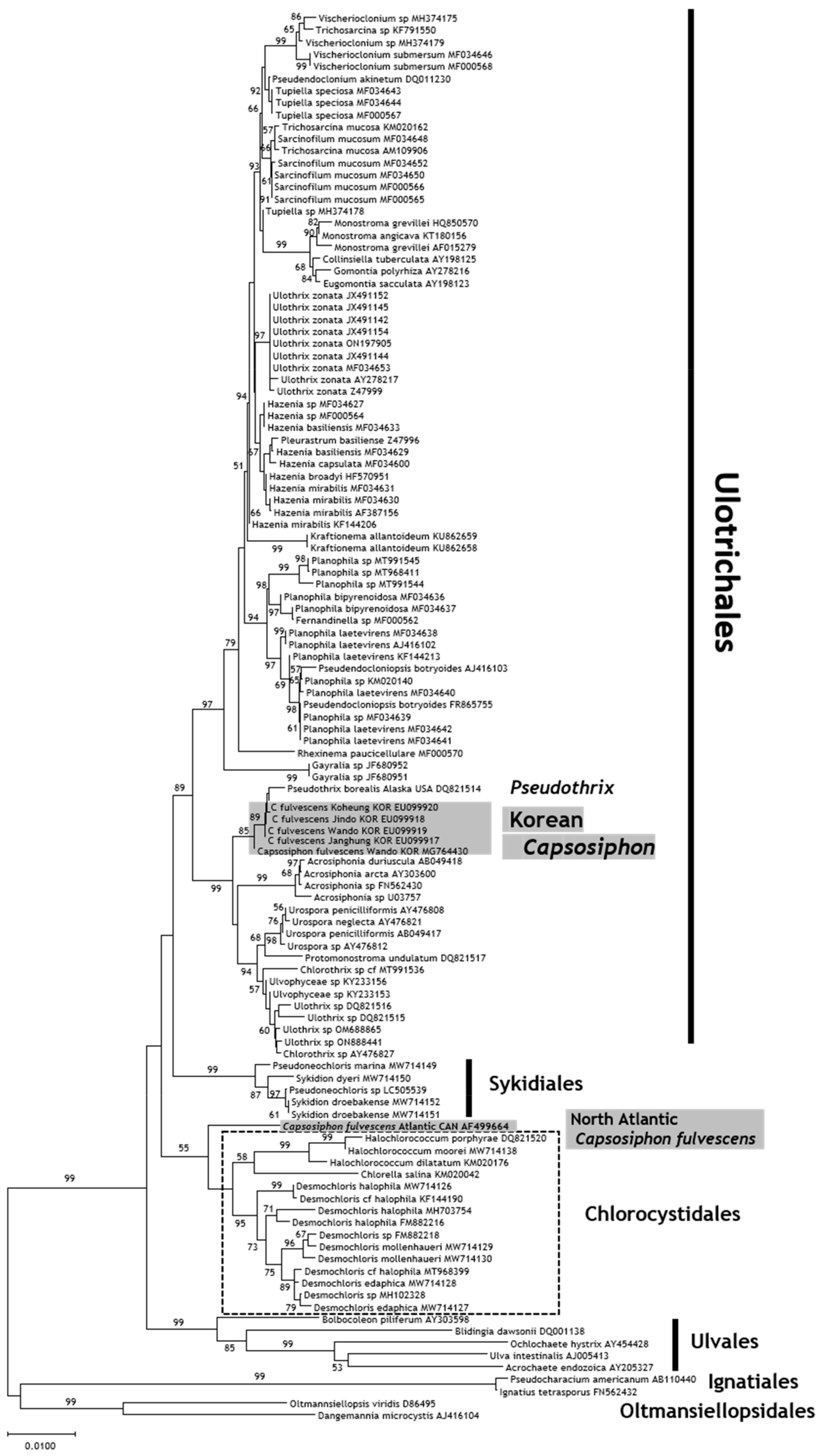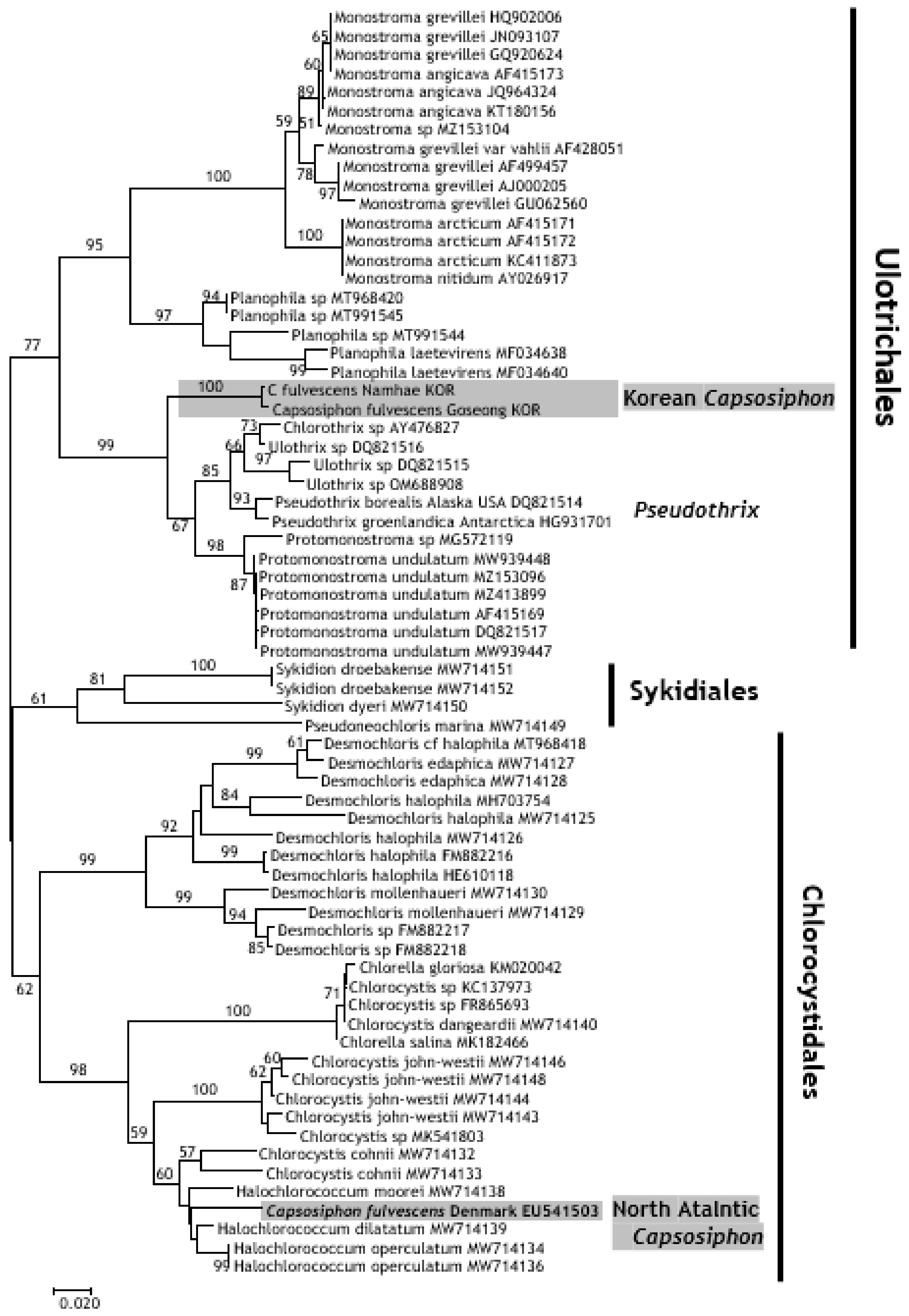1. Introduction
The aquaculture of green macroalgae has recently increased in Asia, and cultivation technologies are being developed for green algae that are putative strains for aquaculture [
1]. Regarding the global production of green seaweed by marine aquaculture during the years 2014–2018, production of
Ulva spp. in Korea, South Africa, and China accounted for 49% of the five-year average relative percentage by weight, whereas
Codium fragile and
Caulerpa spp. accounted for 21 and 5% of the total production, respectively. In Korea,
Capsosiphon fulvescens (
Ulvophyceae,
Ulotrichales;
Maesaengi (in Korean pronunciation)) accounted for 25% of the total production. The taxonomic position of
C. fulvescens was first reported from Northern Europe (type locality: Sweden); however, this species is only cultivated in Korea in the North Pacific region [
2].
In Korea,
C. fulvescens has been used as an edible green alga for approximately 570 years, from the time of the Joseon Dynasty to the present. Taxonomically,
C. fulvescens was first identified as
Ulva fulvescens C. Agardh [
3] and was later established as the genus
Capsosiphon by Gobi [
4]. Interestingly, 370 years before these modern taxonomic studies were conducted,
C. fulvescens was recognized as a taxonomic entity in Korea (Joseon Dynasty) and was named “Maesani” in Korean (Sejong Sillok (1454) Volume 151, Geography of Jeolla-do [Veritable Records of the Joseon Dynasty;
https://sillok.history.go.kr/intro/english.do accessed on 12 February 2025]) [
5]. The physiological and ecological characteristics of this useful seaweed have been described in the Veritable Records of the Joseon Dynasty listed under the Memory of the World Programme (United Nations Educational, Scientific, and Cultural Organization [UNESCO]). This species was widely used as an edible seaweed during the time of the Joseon Dynasty (Revised and Expanded Edition of Survey of the Geography of Joseon, Volume 37, Jeolla-do; Lee Heng [
6]; Jasaneobo, Jeong Yak Jeon [
7]).
Four species have been recorded under the genus
Capsosiphon:
C. aureolus (C. Agardh) Gobi,
C. aureus V.J. Chapman,
C. fulvescens (C. Agardh) Setchell & N.L. Gardner, and
C. groenlandicus (J. Agardh) K.L. Vinogradova [
8]. Among these species,
C. aureolus is currently regarded as a heterotypic synonym of
C. fulvescens, and
C. groenlandicus has been taxonomically changed into a type species of a new genus,
Pseudothrix [
9]. Therefore,
C. fulvescens (C. Agardh) Setchell & N.L. Gardner [
10] and
C. aureus V.J. Chapman [
11] are the only two species currently under the genus
Capsosiphon. The presence of
C. fulvescens has been recorded in Asia, Europe, the Arctic, and the sub-Antarctic islands [
8]. From Korea [
12,
13,
14] and Japan [
15], only
C. fulvescens has been reported. Morphological studies using an indoor culture method [
16,
17,
18,
19] were conducted to analyze the life cycle and reproductive cell characteristics of
C. fulvescens while also assessing its taxonomic position at the order and family levels.
Molecular phylogenetic studies were conducted using the nuclear 18S rDNA and plastid ribulose-1,5-bisphosphate carboxylase/oxygenase large subunit (
rbcL) gene sequences and the plastid genome sequence of
C. fulvescens; the phylogenetic relationships between
C. fulvescens and other green algal species of the orders Ulotrichales and Ulvales were examined [
20,
21,
22]. However, the plastid genome data of
C. fulvescens were insufficient to resolve its taxonomic problems [
22]. Thus, the taxonomic position of
C. fulvescens remains controversial.
Conflicting results have been obtained using previously reported DNA sequences. The phylogenetic relationships between Ulvales and Ulotrichales were examined using 18S rDNA and
rbcL DNA sequences [
20]. The researchers used only the 18S rDNA sequence (GenBank accession number: AF499664) from the Atlantic
C. fulvescens (source information: Monks Head Beach, Nova Scotia) to determine its phylogenetic relationship with other species belonging to Ulvales and Ulotrichales. The results of the study [
20] were cited as important reference data in subsequent reports on molecular analyses [
21,
22]. However, in these subsequent studies [
21,
22], the molecular phylogeny was not analyzed, including that of the key reference of the 18S rDNA sequence from the European
C. fulvescens [
20]. Instead of the previously reported 18S rDNA sequence of North Atlantic
C. fulvescens, ref. [
20,
21,
22] used DNA sequences from the Korean samples. In the absence of a key reference 18S rDNA sequence, the phylogenetic relationships between
C. fulvescens and other species belonging to Ulvales and Ulotrichales were analyzed and discussed in these studies [
21,
22].
Recently, novel DNA sequences (18S rDNA and internal transcribed spacer [ITS] regions) were reported [
23] from unicellular marine coccoid green algae that had not been analyzed in previous molecular phylogenetic studies [
20,
21,
22]. In this study, novel taxa of green algae, belonging to the orders Chlorocystidales and Sykidiales ord. nov., were included [
23]. These novel sequences of the 18S rDNA and ITS regions can be used as novel DNA sequence references for the assessment of the taxonomic position of Korean
C. fulvescens. In another study [
9],
Pseudothrix borealis, previously reported as
C. groenlandicus from North Pacific Amaknak Island (Aleutian Islands, AK, USA), was identified as a new genus based on morphological characteristics and molecular data (DQ821514; 18S rDNA and ITS regions); in this study, the previously reported DNA sequences from the North Atlantic
C. fulvescens were included (AF499664 [18S] and EU541503 [ITS1]).
In this study, we observed genetic differences between 18S rDNA and ITS sequences of the Korean and European
C. fulvescens; therefore, we reexamined the taxonomic position of the Korean
C. fulvescens using 18S rDNA and ITS sequences. Moreover, the results were compared with those obtained using the key reference DNA sequences from the European
C. fulvescens [
9,
20]. We also determined the
rbcL and translation elongation factor EF-Tu (
tufA) gene sequences and examined intraspecific sequence variations for these two genes among Korean populations.
2. Materials and Methods
We examined field samples and herbarium specimens of the Korean
C. fulvescens deposited at the National Institute of Biological Resources (NIBR) in Korea (
Figure 1 and
Figure 2;
Table 1). Commercial goods in the public market were also analyzed. Field samples were collected and directly deposited onto silica gels for DNA analysis. We also used herbarium specimens collected from the Korean Peninsula. The advantage of using herbarium specimens was that samples from a wide range of collection sites could be analyzed, and the cryptic genetic features of Korean algal flora could be detected [
24,
25]. We examined the morphological characteristics of fresh field samples obtained from Korean individuals using a light microscope (Primostar 3; Zeiss, Germany;
Figure 3).
Total genomic DNA was extracted from a single strand of the filamentous plant body using the DNeasy Plant Mini Kit and TissueLyser LT (Qiagen, Hilden, Germany), according to the manufacturer’s instructions [
24]. For the molecular phylogenetic analyses, we selected four DNA markers (nuclear DNA, ribosomal small subunit RNA gene [18S rDNA], ITS region, and plastid DNA:
rbcL and
tufA gene sequences). Nuclear DNA sequences (18S rDNA and ITS) were used as key references to determine the phylogenetic relationships between
C. fulvescens and the related species belonging to Ulvales and Ulotrichales, based on the previously reported molecular phylogenetic studies [
9,
20].
Specific primer combinations were used to amplify the target regions (18S rDNA: A/SSU-inR1 [
26]; ITS region: ITS1/ITS4 [
27];
rbcL: RH1/rbc590 [
20,
28];
tufA: tufAF/tufAR [
29]) using amfiXpand PCR Master Mix (GenDEPOT, Barker, TX, USA). The reaction conditions were as follows: 3 min at 95 °C followed by 40 cycles of 30 s at 94 °C, 30 s at 50 °C, and 1 min at 72 °C, with a final 7 min at 72 °C; the reactions were performed using a Thermal Cycler 9700 (Applied Biosystems, Foster City, CA, USA). The amplified PCR products were purified and sequenced in both directions (GenoTech, Daejeon, Republic of Korea). Chromatograms were assembled using Sequencher version 5.4.6 (Gene Codes, Ann Arbor, MI, USA), and the Basic Local Alignment Search Tool (BLAST;
http://blast.ncbi.nlm.nih.gov/Blast.cgi accessed on 12 February 2025)as used to search for similarities between the identified and reference sequences. For molecular phylogenetic analysis, we aligned the sequences and inferred phylogenetic trees using the neighbor-joining and maximum likelihood methods using the MEGA program (version 6) [
30]. The taxonomic position of Korean
C. fulvescens in relation to European
C. fulvescens remained consistent, despite model changes; therefore, we primarily represented the phylogenetic tree using the neighbor-joining method. Additionally, phylogenetic trees were analyzed using the maximum likelihood method (
Figures S1 and S2). Pairwise distances were calculated using Kimura’s two-parameter model.
3. Results
In this study, we determined the 18S rDNA, ITS region, and
rbcL and
tufA gene sequences of the Korean samples of
C. fulvescens (
Table 1). The 18S rDNA sequences were isolated from nine samples of Korean
C. fulvescens (5′-end partial sequences; 520 bp), and no intraspecific variation was found among the samples (GenBank accession number: PQ555428). A BLAST search revealed that our 18S rDNA sequences showed 100% similarity with the
C. fulvescens sequences reported in previous studies (MG764430 in [
22] and EU099917, EU099919, and EU099920 in [
21]). A one-base difference was found between our 18S rDNA sequences and the EU099918 sequence (Jindo, Republic of Korea [
21]). The species that was most closely related to the Korean
C. fulvescens in terms of DNA sequence similarity (99.8%) was
Pseudothrix borealis (DQ821514), which was previously identified as the North Pacific
C. groenlandicus. The novel genus
Pseudothrix was established in a later study [
9]. In contrast, the Korean
C. fulvescens was distantly related to the North Atlantic
C. fulvescens (AF499664) reported in another study [
20] (92.7% similarity). A BLAST analysis of the long DNA sequences obtained from the Korean
C. fulvescens (EU099917–EU099920 and MG764430) revealed that these sequences showed 100% similarity with our sequences; the North Atlantic
C. fulvescens (AF499664) showed 97% similarity (723/749) with our
C. fulvescens samples. Phylogenetic analysis of 18S rDNA was conducted using long DNA sequences, including those from the Korean
C. fulvescens (MG764430;
Figure 4).
The ITS sequences of the Korean
C. fulvescens were determined; nine sequences (569 bp) were elucidated using field samples, herbarium specimens, and commercial goods available from public markets (
Table 1). We found two ribotypes with a one-base difference among the Korean population (62nd position in the ITS1 sequence: A (GenBank accession number PQ557621) or G (PQ557622). In the case of commercial goods in the public market (Jangheung 1, Republic of Korea; PQ557623), the mixed base R (A/G) was found at the 62nd position. This indicates the presence of mixed strains in aquaculture farms of
C. fulvescens. A similarity search revealed that the ITS sequences from the Korean samples of
C. fulvescens were different (82% similarity) from those of the North Atlantic
C. fulvescens (Kattegat, Denmark) [
9]. In contrast, the Korean
C. fulvescens ITS sequences showed the highest similarity (94.5%) with ITS sequences from
Pseudothrix borealis (
Capsosiphon groenlandicus DQ821514 in [
9]) and less than 93.5% similarity with those from the other species belonging to Ulotrichales.
We also determined 12 sequences of
rbcL (547 bp) using field samples, herbarium specimens, and commercial goods in the public market and six sequences (930 bp) of
tufA using field samples (
Table 1). The
rbcL (G-type; PQ561385) and
tufA sequences (PQ561386) showed 100% similarity to the previously reported sequences of the Korean
C. fulvescens (MG727869 in [
22]). The
rbcL gene sequence from the Korean
C. fulvescens showed 93.5% similarity with sequences reported from the other species of Ulotrichaceae deposited in GenBank (National Center for Biotechnology Information, NCBI); the
tufA sequence showed less than 93% similarity to sequences reported from the other green algae deposited in GenBank (NCBI). Two haplotypes of the
rbcL gene were found among the Korean populations (A (PQ561384) or G (PQ561385)) at the 418th position in the
rbcL gene sequence), including the previously reported gene sequence from the Korean
C. fulvescens (G in MG727869).
Molecular phylogenetic analyses were conducted using sequences of 18S rDNA and ITS regions (
Figure 4 and
Figure 5) because these were key reference DNA sequences obtained from the European
C. fulvescens in previous studies [
9,
20]. The Korean
C. fulvescens formed a separate group from the European
C. fulvescens in the phylogenetic tree prepared using the 18S rDNA and ITS sequences. The Korean
C. fulvescens formed a sister group with
Pseudothrix borealis and was placed under the order Ulotrichales in the tree constructed using the 18S rDNA sequences (
Figure 4); the Korean
C. fulvescens clustered with
Pseudothrix and
Protomonostroma in the tree constructed using the ITS sequences (
Figure 5). The European
C. fulvescens formed a clade with the species belonging to Chlorocystidales and was distantly related to the Korean
C. fulvescens. The North Pacific and North Atlantic
C. fulvescens showed differences in their classification as green algae.
4. Discussion
The green alga
C. fulvescens has been used as an essential edible economic alga in Korea since the time of the Joseon Dynasty (approximately 570 years ago). Its industrial use in Korea has predated modern taxonomic studies on this species in Europe by several hundred years [
3,
4]. This species has been used as an aquaculture species in Korea [
2,
31,
32]. Currently, this species is important in aquaculture [
1]. Although molecular phylogenetic studies have been conducted to determine the taxonomic relationships between
C. fulvescens and other species of Ulotrichales and Ulvales, this topic remains debatable [
20,
21,
22].
One of the causes for this confusion is the lack of genetic data required for conducting molecular phylogenetic studies [
21,
22]. In a report [
20], the phylogenetic classifications reported in previous studies were summarized; the taxonomic relationships between the European
C. fulvescens and other species belonging to Ulotrichales and Ulvales were also examined in that study using 18S rDNA and
rbcL gene sequences. In particular, the researchers used only the 18S rDNA gene sequences to determine the taxonomic relationships among the species belonging to Ulotrichales and Ulvales. In another study [
9], the 18S rDNA and ITS regions were examined using samples of the North Atlantic
C. fulvescens and North Pacific
Pseudothrix borealis (previously reported as
C. groenlandicus). However, in two subsequent studies [
21,
22], these key reference DNA sequences [
9,
20] were not considered during the analysis of the taxonomic relationships between
C. fulvescens and other Ulotrichales and Ulvales species. The authors deduced the phylogenetic relationships using only the Korean samples of
C. fulvescens and did not analyze the ITS region sequences from those samples [
21,
22].
In this study, we determined the 18S rDNA and ITS sequences of the Korean
C. fulvescens. The Korean
C. fulvescens showed a high degree of sequence variation and a distant phylogenetic relationship with the European
C. fulvescens (
Figure 4 and
Figure 5). Analysis of phylogenetic trees constructed using 18S rDNA and ITS sequences revealed that the Korean
C. fulvescens was closely related to
P. groenlandica (J. Agardh) Hanic & S.C. Lindstrom [
9] (Ulotrichaceae, Ulotrichales).
P. groenlandica was initially identified as
C. groenlandicus from North Pacific Alaska and was taxonomically reexamined in a subsequent study [
9]. In this report [
9], the ITS sequence (EU541503) obtained from the North Atlantic
C. fulvescens samples collected at Hirsholm, Kattegat, Denmark (by Ruth Nielsen; 1 September 1988) was published. The collection site was located near the type locality of
C. fulvescens (Landskrona, Sweden, South of Kattegat). The ITS sequence of the North Atlantic
C. fulvescens showed a high degree of sequence variation with that of the Korean
C. fulvescens (82% similarity); the North Atlantic and Korean
C. fulvescens formed distinct groups in the phylogenetic tree constructed using these ITS sequences (
Figure 5).
The European
C. fulvescens formed a cluster with the species putatively belonging to Chlorocystidales in the phylogenetic tree (
Figure 4 and
Figure 5). In contrast, the Korean
C. fulvescens showed a close taxonomic relationship with the species belonging to Ulotrichales. In a report [
23], novel DNA sequences (18S rDNA and ITS regions) from unicellular marine coccoid green algae belonging to the orders Chlorocystidales and Sykidiales nov. were published. These species were not included in previous molecular phylogenetic studies [
21,
22]. The plastid genome sequence data from
C. fulvescens [
22] were insufficient to determine the taxonomic position of
C. fulvescens. However, data obtained from multiple taxa have been frequently used to resolve taxonomic problems (e.g., [
33]). Therefore, we included the novel 18S rDNA and ITS sequences obtained from species belonging to Chlorocystidales and Sykidiales [
23] in our analysis to determine the taxonomic positions of
C. fulvescens from the North Pacific and North Atlantic regions (
Figure 4 and
Figure 5).
The results revealed that the North Pacific and North Atlantic
C. fulvescens were separate taxonomic entities that were not closely related to each other. These species were placed in different taxonomic groups, putatively in Ulotrichales and Chlorocystidales, respectively (
Figure 4 and
Figure 5). Additionally, the results suggested that the Korean
C. fulvescens should be placed in a new taxonomic group. In this study, we could not examine the type specimen of
C. fulvescens and conducted a global sampling of
C. fulvescens. Further studies including the type specimen and global samplings should be addressed for nomenclatural treatments.
In summary, we conducted a molecular phylogenetic analysis of the Korean C. fulvescens and examined the intraspecific DNA sequence variations. We believe that this genetic information will be useful for inferring the taxonomic relationships between C. fulvescens and other species belonging to Ulotrichales and Ulvales. These findings will help in tracing the origin of the North Atlantic C. fulvescens. Moreover, genetic variations in the ITS and rbcL sequences can be used to differentiate between various populations of the Korean C. fulvescens; this would also provide a helpful tool for the development of C. fulvescens as an aquaculture strain in Korea.
